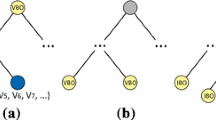Abstract
Visibility computations, exhibiting a quadratic growth rate, are the bottleneck of high quality, real-time rendering of 3D models. In order to speed up visibility computations parallel or distributed-computing techniques can be used. Recent research demonstrates that scanline algorithms are suitable for balancing the workload and reducing the communication overhead of multiprocessor architectures. This paper summarizes known scanline algorithms and proposes a new one that takes time proportional to N log2 N and storage space proportional to N in the worst case, where N is the number of input line segments. The advantages of the proposed algorithm include that it can take real values obtained by the intersection of a 3D scene with the plane of the scanline as input and that it is optimal under several models of computation.
Preview
Unable to display preview. Download preview PDF.
Similar content being viewed by others
References
Angel, E.: Interactive Computer Graphics: A Top-Down Approach Using OpenGL, 4th edn. Addison-Wesley, Reading (2006)
Atallah, M.J., Cole, R., Goodrich, M.T.: Cascading divide-and-conquer - a technique for designing parallel algorithms. SIAM Journal on Computing 18(3), 499–532 (1989)
Bittner, J., Wonka, P.: Visibility in Computer Graphics. Center for Applied Cybernetics Czech Technical University in Prague, TR-186-2-03-03 (2001)
Catmull, E.: Computer display of curved surfaces. In: Proc. IEEE Conference Computer Graphics Pattern Recognition Data Structure, vol. 11 (May 1975)
Cohen-or, D., Chrysanthou, Y., Silva, C.T., Durand, F.: A survey of visibility walkthrough applications. In: IEEE Transactions on Visualisation and Computer Graphics. IEEE Computer Society Press, Los Alamitos (2002)
Dalal, S., Rahman, M.M.: An efficient scanline-based System for the visualisation of large data sets. In: Proc. International Conference on Computer Graphics, Imaging and Vision 2005 (CGIV05), Beijing, China, July 26-29, 2005 (2005)
Dalal, S., Dévai, F., Rahman, M.M.: High-performance rendering on clusters of workstations. In: Proc. International Conference on Geometric Modeling & Imaging 2006 (GMAI06), London, July 4–7 (2006)
Dévai, F.: Complexity of two-dimensional visibility computations. In: MICAD’84. Proc. 3rd European Conference on CAD/CAM and Computer Graphics, Paris, France, vol. 3, pp. 827–841 (1984)
Dévai, F.: An O(log N) parallel time exact hidden-line algorithm. In: Kuijk, A.A.M., Strasser, W. (eds.) Advances in Graphics Hardware II, pp. 65–73. Spring, Germany (1988)
Dévai, F.: Approximation algorithms for high-resolution display. In: Péroche, B. (ed.) Proc. PIXIM’88, First International Conference on Computer Graphics in Paris, France, pp. 121–130 (1988)
Dévai, F.: An optimal parallel algorithm for the visualization of solid models. In: Applications of Supercomputers in Engineering III, pp. 199–210. Elsevier Applied Science, London (1993)
Dévai, F.: On the computational requirements of virtual reality systems. In: State of the art Reports, Eurographics’97, Budapest, Hungary, pp. 59–92 (September 1997)
Durand, F.: 3D visibility: analytical study and applications. PhD Thesis, University of Joseph Fourier, Grenoble, France (1999)
Foley, J.D., vam Dam, A., Feiner, S.K., Hughes, J.F.: Computer Graphics Principles and Practice, 2nd edn. Addison-Wesley, Reading (1990)
Fuchs, H., Kedem, Z.M., Naylor, B.: On visible surface generation by priory tree structures. Comput. Graph. 14(3), 124–133 (1980)
Gordon, D., Chen, S.: Front-to-back display of BSP trees. IEEE Comput. Graph Appl. 11, 79–85 (1991)
Grant, C.W.: Visibility Algorithms in Image Synthesis. PhD Thesis, University of California, Davis (1992)
Knittel, G., Schilling, A., Strasser, W.: GRAMMY: High performance graphics using graphics memories. In: Chen, M., Townsend, P., Vince, J.A. (eds.) High-Performance Computing for Computer Graphics and Visualisation, pp. 33–48. Spring, London (1996)
Ma, K., Painter, J.S., Hansen, C.D., Krogh, M.F.: Parallel volume rendering using binary-swap image composition. IEEE GG&A (July 1994)
Molnar, S., Eyles, J., Poulton, J.: PixelFlow: High-speed rendering using image composition. Computer Graphics. In: Proc. SIGGRAPH 92, vol. 26(2), pp. 231–240 (July 1992)
Molnar, S., et al.: A sorting classification of parallel rendering. In: IEEE Computer Graphics and Applications, pp. 23–32. IEEE Computer Society Press, Los Alamitos (1994)
Preparata, F.P., Shamos, M.I.: Computational Geometry, An Introduction, p. 390. Springer, Heidelberg (1985)
Rahman, M.M.: A scanline-based distributed system for the visualisation of large data sets. In: Geometric Modeling and Computing, Seattle, vol. 2003, pp. 469–480 (2003)
Rogers, D.F.: Procedural Elements for Computer Graphics, pp. 284–292. McGraw-Hill, New York (1985)
Sutherland, I.E., Sproull, R.F., Schumacker, R.A.: A Characterization of Ten Hidden-Surface Algorithms. ACM Computing Surveys 6, 1–55 (1974)
Tóth, C.D.: A note on binary plane partitions. In: Discrete and Computational Geometry, vol. 30, pp. 3–16. Springer, New York (2003)
Wang, Q.: Networked Visual Reality. Master Thesis, University of Alberta (1994)
Warnock, J.E.: A hidden-surface algorithm for computer generated half tone pictures. University of Utah Computer Science Dept. Rep., pp. 4–15 (June 1969)
Zhang, H.: Effective Occlusion Culling for the Interactive Display of Arbitrary Models. Ph.D. thesis, Department of Computer Science, UNC, Chapel Hill (1998)
Author information
Authors and Affiliations
Editor information
Rights and permissions
Copyright information
© 2007 Springer-Verlag Berlin Heidelberg
About this paper
Cite this paper
Rahman, M.M. (2007). Visibility Computations – Scanline Algorithms and Techniques. In: Gervasi, O., Gavrilova, M.L. (eds) Computational Science and Its Applications – ICCSA 2007. ICCSA 2007. Lecture Notes in Computer Science, vol 4706. Springer, Berlin, Heidelberg. https://doi.org/10.1007/978-3-540-74477-1_3
Download citation
DOI: https://doi.org/10.1007/978-3-540-74477-1_3
Publisher Name: Springer, Berlin, Heidelberg
Print ISBN: 978-3-540-74475-7
Online ISBN: 978-3-540-74477-1
eBook Packages: Computer ScienceComputer Science (R0)




